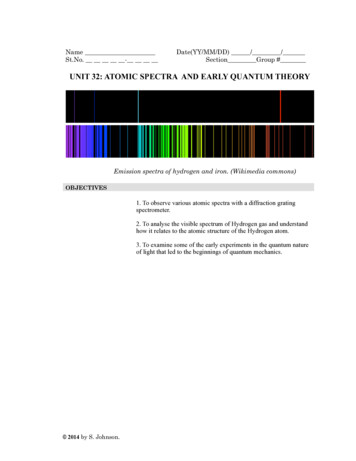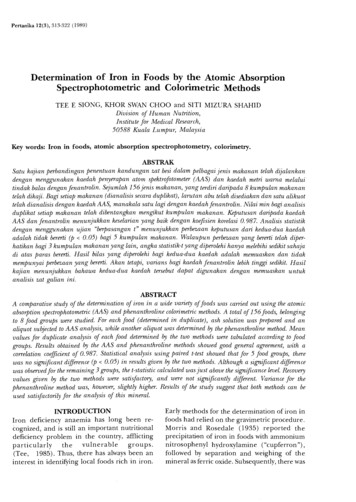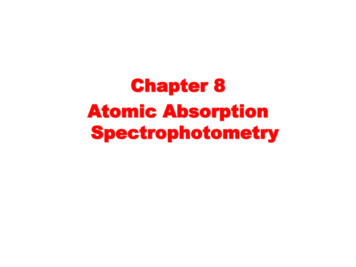
Transcription
Atomic data for iron-group elements of astrophysicalinterest.NIST:Gillian Nave, Craig Sansonetti.Imperial College, London:Juliet Pickering, Matthew Ruffoni, Anne Thorne, Florence Liggins.Program is a collaboraton between NIST and Imperial College, London,with ICL carrying out measurements of UV FT spectra and NIST themeasurements of vis/IR FT spectra and VUV/UV gratng spectra.
Why iron-group elements?Iron-group elements are found in almost all astrophysical objects,including: Stars. Nebulae around stars. Inter-stellar and inter-galactc medium. Galaxies Quasi-stellar objects and QSO absorpton-line systemsAccurate atomic data are needed to interpret the spectra from allof these objects.
What atomic data are needed?Data needs include: Line identifications: chemical abundances, blended lines. Wavelengths: for radial velocites, line identficaton, α. Oscillator strengths: chemical abundances, spectrum synthesis. Hyperfine & isotope structure: abundances, spectrum synthesis
Iron-group elements in χ Lupi: accurate lineidentficatons are essental!Figure from Brandt et al. Astron. J. 117, 1505-1548 (1999)
Iron-group elements in η Carinae“The measurements of velocities and column densities of the ejecta absorption linesare highly dependent on the availability and accuracy of atomic data” (Nielsen & Gull,Phs. Scr. T134, 2009)
Spectroscopic surveys:Gaia-ESO Public Spectroscopic Survey (visible)Gaia-ESO survey complements ESA'sGAIA mission.GAIA will perform astrometry &photometry on stars mag 20.Gaia-ESO survey is measuring visibleregion spectra of 105 stars usingFLAMES (UVES & GIRAFFE)spectrographs on UT2 of ESO's VLT.Oscillator strengths are needed in Fe Ifor lines with poor ratngs in NISTAtomic Spectra Database (D or E).FLAMES/GIRAFFE: 130 targets, R 25000.FLAMES/UVES: 8 targets, R 47000Wavelengths: 300 nm – 1100 nm.
APOGEE: Apache Point Observatory Galactc EvolutonExperimentPart of the SDSS III & aims to measurechemical abundances for 100,000 stars.Cryogenic Spectrograph with R 24,000Wavelengths: 1.51 – 1.68 µm (H-band)Abundances to 0.1 dex ( 25%) for 105 starsProblem:Few IR oscillator Joint project between ICL, NIST, & Univ. Wisconsin, Madison to measure Fe I4d-4f, 5s-5p transitons.
Recent work on iron-group spectra(energy levels and wavelengths)Element1st spectrum2nd spectrum 150 nmTiForsberg 1991unpub. in ASDVThorne et al. 2011In progress at ICLCrWallace et al. 2009 ( 250 nm)/ in progress at ICLMnIn progress at ICL/NISTFeNave et al. 1994CoPickering et al (1996 )(incl. HFS for 297 levels)Pickering et al. (1998)NiLitzén et al (1993)Begun at ICL2nd spectrum 150 nmScSansonetti et al. (UV in press, vis/IR in progress.Begun at ICLNave et al. (submitted)Older grating measurements are available for many spectra, but are of variable quality.Comprehensive HFS measurements completed for Co I, but missing for many other elements.
SourcesHigh current hollow cathode source.Suitable for neutral and singlyionized spectra.Penning discharge source.Suitable for singly-ionized anddoubly-ionized spectra.
IMPERIAL COLLEGE FTS LABORATORYPart ofof thethe SpaceSpace && AtmosphericAtmospheric PartPhysics GroupGroupPhysicsFT spectrometersspectrometers 22 FTMaximum path difference20 cmResolving power2,000,000 @ 200 nmResolution limit0.025 cm-1Maximum free spectral range64,000 cm-1Wavelength range covered1.15 µm 135 nm Transition wavelengths: few parts in 108 uncertainty FTS linelist & energy level uncertainty 0.002 cm-1 Imperal College London
NIST 2-m vis/IR Fourier transform spectrometerWavelength range: 2200 Å – 5.5 µm.Resolution: 0.0025 cm-1 (4 million at 1 µm).Typical wavelength uncertainty for strong lines: 3:108
Grating SpectrometerNormal incidence vacuum spectrograph.Wavelength range: 300 Å - 5000 Å.Resolving power: 150000 (1st order, on photographic plates).
Photographic plates vs image platesPhotographic platesPhosphor image platesWavelengths up to 5000 ÅWavelengths up to 2200 ÅResoluton of a few µm.Resoluton of 50 µm.Non-linear intensity scaleLinear intensity scaleNo longer manufacturedCommercially availableSingle useReusableBoth types of plates are being used for this project. We have about 100photographic plates in storage.If you have photographic plates of iron-group elements we would bevery interested in collaborating with you !!!
New scanner for photographic plates.NIST currently has: About 2000 plates from normal incidence spectrograph. Similar number from Grazing incidence spectrograph. About 1100 Zeeman plates from MIT. Assorted plates from other spectrographs (few hundred?)Many of these plates are unique and cannot be taken again.We are investgatng designs to provide rapid scanning of these plates.
Term AnalysisFTS dataGrating dataCalibrationCalibrationLinelistTabulated data,other observationsadditionalinformationknown levelsleveloptimizationsortingAr, Ne line,neutral linessingly-ionized linelistidentificationidentified linesoptimized levelvalueslevel searchnew levelsanalysisfinal identifiedlinelistunidentified linestheoreticalpredicitions
Fe II (NIST)G. Nave, S. Johansson, Ap J. Suppl. Series (submitted)See poster #4 on Wednesday Measurements using FTS and gratng spectroscopy. 12 887 spectral lines classified using 1027 energy levels (13654transitons). Spectral range 900 Å – 5 µm. Uncertaintes of FT spectra from 0.0001 cm-1 in IR to 0.05 cm-1 in UV. Uncertaintes of gratng lines are 0.005 cm-1. Ritz wavelengths for all lines – brings gratng data to FTS precision. Spectra being put into ASD as soon as they are published.
Ultraviolet spectrum of Cr II (NIST/ESA/ESO)C. J. Sansonetti, G. Nave, J. Reader, F. Kerber, Ap. J. Suppl. Series 202, 15 (2012).See poster # 6 on Monday FTS and gratng observatons in region 1142 – 3954 Å in press. 3600 lines classified using 651 levels of Cr II. Uncertaintes reduced by about a factor of 20.Visible/IR spectra of Cr IINew spectra recorded with NIST 2-m FTS in region 4000 Å to 5.5 µm.Brings total of classified lines to almost 4500, covering 1130 Å – 5.5 µm.Total number of optmized levels now 728.
Fluorescence lines of Cr in η CarSTIS spectrum of oneof the Weigelt blobsT. Zethson et al., ASPConf. Ser. 242, 97 (2001)Laboratoryspectrum
V IIA. P. Thorne, J. C. Pickering, J. I. Semeniuk, Ap. J. Suppl. Series (in press)FTS spectra of V/Ne hcl covering 1490 Å – 5800 Å. 1242 lines of V II from 409 levels.Plot shows difference between revised and previous energy levels of V II (Iglesias, Catalan et al).Uncertainty of the new level energies is typically in the range from 0.002cm-1 to 0.005cm-1.
Mn I (NIST/IC)R. Blackwell-Whitehead, J. Pickering, G. Nave, in preparaton Analysis of both of these spectra was begun at Imperial College (ICL),London, using spectra from ICL and NIST. List of about 1300 lines of Mn I measured using FTS, classified using275 levels. Covers region 1913 Å ̶ 5.1 µm with uncertaintes of 0.001̶ 0.005 cm-1. Poor agreement between observed wavelengths and Ritzwavelengths suggests level optmizaton can be improved.
Co IIID. G. Smillie, J. C. Pickering, G. Nave, P. L. Smith (in preparaton)List of about 1100 lines of Co IIImeasured using FTS and gratngspectroscopy with phosphorimage plates.Co/Ne Penning discharge source:1.7 A, 0.1 Pa Ne.Covers region 610 Å to 2564 Å withuncertaintes of 0.004 cm-1 forFTS lines.Classified using 215 Co III levels:best improvement is going to befor the 4s-4p lines.
09133.1186Are lists of classified lines enough?Lines in spectrum of Fehollow cathode lamp.Present in new paperFigure from Brandt et al. Astron. J.117, 1505-1548 (1999)We need lists of unclassified lines too!
AcknowledgmentsWork at NIST is supported by NASA under inter-agencyagreement NNH10AN38I (Jan 2010 – Dec 2012, recentlyrenewed)Work at ICL is supported by U. K. Science & Technology FacilitesCouncil.We thank all the astronomers who have given us support in thepast. Contnued strong support by the astronomical communityis absolutely vital for this work to contnue!
V Thorne et al. 2011 In progress at ICL Cr Wallace et al. 2009 ( 250 nm) / in progress at ICL Sansonetti et al. (UV in press, vis/IR in progress. Mn In progress at ICL/NIST Begun at ICL Fe Nave et al. 1994 Nave et al. (submitted) Co Pickering et al (1996 ) (incl. HFS for 297 levels) Pickering et al. (1998) Ni Litzén et al (1993) Begun at ICL











